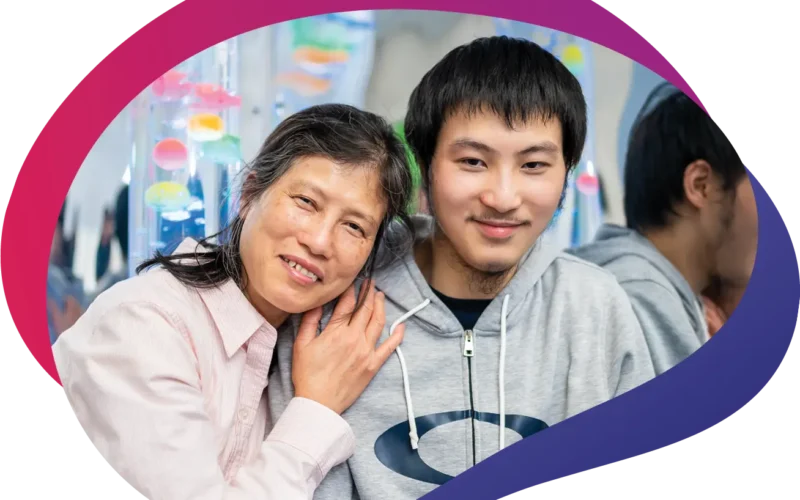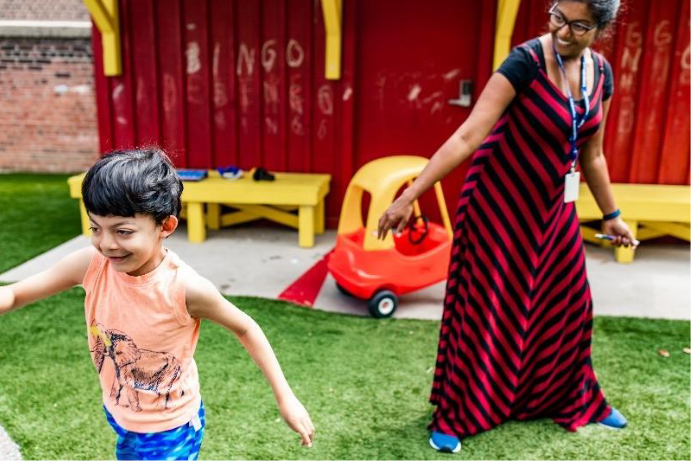From the time we wake up and until we go to sleep, we constantly use our sight. It helps us with day-to-day social and spatial interactions, and it’s a big part of a child’s development, which includes their learning and play skills.
In support of Vision Health Month, we sat down with Lindsay Hillier, Manager of our Blind-Low Vision Early Intervention Program, to learn more about vision health, how to protect it, and why it’s important for children with autism and other developmental disorders.
Thanks for chatting with us, Lindsay! Let’s take it back to the beginning. Can you explain how vision develops?
Lindsay: Sure! Happy to explain. Vision development begins in the womb and continues throughout childhood and adolescence. The visual system is the most complex sensory system in the human body, but it’s actually the least mature system at birth! A child’s vision is a complex combination of the brain, the eyes and the vast array of nerves that connect them. A child’s experiences and environment have a big impact on the development of vision. This is because young children learn through their eyes. They watch and imitate what they visually observe in their lives. These experiences are important for vision to develop fully.
Even after your vision is fully developed, why is it important to stay on top of vision health throughout your life? What are some ways to protect it?
Lindsay: Not many people know that 75% of vision loss can be prevented or treated with proper care. There are lots of things you can do to protect your eye health. Here are some tips:
- Get yearly eye exams. Just as we go to the family doctor to monitor our general health and the dentist to check on our oral health, regular visits to an optometrist or an ophthalmologist are how we maintain good vision health! The Ontario Health Insurance Plan (OHIP) covers free yearly eye exams for children under 19. Many adults have insurance that covers annual eye exams.
- Wear sunglasses to protect your eyes and keep sun damage to a minimum. Look for sunglasses that block out 99% to 100% of UV-A and UV-B radiation (the sun’s rays), which, believe it or not, you should even wear on cloudy days if possible. Frequent exposure to UV rays has been linked to numerous eye conditions such as cataracts, macular degeneration, and more.
- Wear safety glasses and protective goggles when you play sports or work with hazardous materials. Safety glasses lower your risk for eye injury, vision damage and complete loss of sight.
- Keep your eye prescription up-to-date. This will ensure you can see as clearly as possible. A comprehensive eye exam can also detect potentially life-threatening conditions, like brain tumours, high blood pressure and diabetes.
At what age are children eligible to have their eyes examined?
Lindsay: A child of any age is eligible to have an eye exam. Children can have an eye exam as soon as 6 months of age and should have 3 eye exams before they begin school. If you have any concerns about your child’s vision, see an eye care professional regardless of your child’s age.
Why is it important that vision care be a part of assessing children with autism spectrum disorder and other developmental disorders?
Lindsay: Vision problems occur at higher rates in children with autism spectrum disorder than in the general population. Recent research shows that about 40% of children with autism have some type of identifiable vision problem. Some of the most common – but usually treatable – issues are refractive error (the child needs glasses), strabismus (their eyes are not properly aligned), and amblyopia (one eye is weaker than the other).
Depending on their age, a child may not have the language or ability to explain how they see or attribute how they feel to a vision problem. In fact, observable behaviour believed to be related to autism may be a sign of an undiagnosed vision problem, which is why eye exams are important! Having visual issues addressed can make a big difference for children with autism to participate in their daily life activities.
We have a great team of early childhood vision consultants here at Surrey Place. Can you share how our Blind-Low Vision Early Intervention Program helps children?
Lindsay: Our program helps young children with visual impairment by supporting their parents and caregivers. Having access to learning is so important for children. We work with families to ensure that the environment, materials, toys, and interactions allow children to have rich learning opportunities. Some children without sight will learn to use their tactile and auditory skills to access learning, while other children with low vision and neurological visual impairments will learn to use their remaining vision and other senses. Our team also provides vision and sensory assessments to help the families and the professionals understand what will be most helpful for the children.
Thanks for answering our questions today! Any final thoughts?
Lindsay: No problem! If there’s one major takeaway from Vision Health Month, it’s that vision health is for everyone, no matter what your age! If you have any concerns about your eye health, don’t hesitate to visit your optometrist or ophthalmologist for a check-up. Or, if you’d like support for your child’s visual impairment, connect with us here at Surrey Place.
Visit our directory to learn more about our Blind-Low Vision Early Intervention Program.


